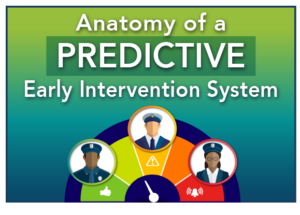
An early intervention system (EIS) can be an instrumental tool for law enforcement agencies looking to track and address problematic patterns in officer behavior. The ideal EIS should be proactive in nature by enabling leadership to identify off-track behavior before it becomes a real problem — and should work seamlessly within the agency’s unique organizational needs and culture. Conversely, an EIS should also be able to identify positive patterns of behavior in officers exhibiting exemplary performance.
This spring, Benchmark Analytics conducted a webinar delving deep into this subject as part of our ongoing Data Dialogue series. Panelists included Ron Huberman, CEO of Benchmark Analytics and Nick Montgomery, Chief Research Officer at Benchmark. The dialogue centered around four principal areas concerning EIS: its evolution, data significance, its departmental adaptation, and perceptions towards its daily use by agencies and officers.
Evolution of Early Intervention Systems
Huberman, who rose through the ranks of the Chicago Police Department to serve as Assistant Deputy Superintendent, shed light on the progression of EIS within police departments — tracing its origins from the 1970s up to the recent advancements of today. Initially, departments utilized rudimentary “trigger-based” systems. However, these systems often produced “false positives” and “false negatives.”
As Huberman explained, “The University of Chicago published a lot of compelling research that showed trigger-based systems typically had a 70% false positive problem, which means 70% of the time it was flagging officers that were doing their job as they should. Furthermore, they had about a 40% false negative problem, meaning they were actually missing officers who were really struggling out there.”
While policing continued to evolve around more data-centric solutions, early intervention systems failed to keep up — until the introduction of First Sign® by Benchmark. First Sign offers a research-driven early intervention system that utilizes various data sources, including arrest records and use-of-force reports, with machine learning to identify predictive patterns. The digital transformation of departmental records and advanced algorithms provide a level of accuracy that trigger-based systems lacked at the time and still do to this day.
The Power of Integrated Datasets
Benchmark’s Chief Research Officer Nick Montgomery emphasized the power of converging various departmental datasets. An amalgamation of data, including over twenty event markers, can lead to over ninety predictive variables for each officer. This holistic approach greatly enhances the understanding of officer behavior compared to analyzing singular incidents. As he so powerfully stated, “…a research-based early warning system takes all of the data inside a police department looking back over five, ten, fifteen years and uses those various patterns of behavior to create a system that is far more predictive and can accurately identify officers likely to have an adverse event based on past events.”
Proactive Prevention of Harm
Early intervention systems can offer valuable insights by identifying officers exhibiting at-risk behavior, allowing for prompt intervention through training or counseling before problems escalate. Research conducted with the University of Chicago demonstrates that traditional EIS platforms using threshold-based triggers have a 70% fallacy rate for flagging at-risk officers. In contrast, First Sign boasts an 85% efficacy rate. Furthermore, our findings suggest that no more than 5% of officers contribute to over 60% of excessive force incidents.
Addressing the challenges with this specific group can significantly enhance community trust. Constructive, non-punitive supervision remains crucial for the efficacy of early intervention systems. In Huberman’s words, a modern research-based system like First Sign enables supervisors to say, “‘Hey, Officer Smith – I know you’re a good guy – and a good officer – but you were flagged in the system, so it’s important I intervene. Let’s talk about next steps to correct your at-risk behavior and how you’re engaging the public.'”
Signs of Impact
Preliminary data suggests that the implementation of an EIS can yield tangible results. Huberman shared data indicating a 50% reduction in the severity of force used by flagged officers post-supervisory intervention. Complaint rates against these officers also saw a significant decrease. Importantly, essential enforcement activities remain largely unaffected. And how do we know this? Benchmark has the world’s largest database on officer performance — and we’ve validated all predictive analytics through a standardized national model developed in partnership with the University of Chicago.
Embracing Modernization: The Future of Policing
In today’s rapidly evolving world, modernization touches every corner of our lives, from how we communicate to how we conduct business. Similarly, the realm of law enforcement isn’t exempt from this wave of change. The adoption of research-based methodologies combined with technological innovation reflects the evolution of policing in line with modern trends.
Historically, police reform efforts have been broad and overarching, often applying wide-reaching solutions like general de-escalation training for entire forces. But as we’ve seen, these blanket approaches might not always address the nuances and individual needs of officers. In many cases, the emphasis is shifting to more tailored tactics and tools, most likely powered by data science and analytics.
By harnessing the capabilities of modern data science, First Sign Early Intervention allows for a more focused course of action, directly targeting officers who genuinely need support. As a result, law enforcement stands at a pivotal moment where trust can be fostered within the communities they serve, internal personnel practices improved, and genuine change affected.
As Ron Huberman eloquently summarized, “There’s a tremendous opportunity before all of us in this profession – who view it as a noble calling and care deeply about policing – to say, ‘Let’s make a difference. Let’s turn this corner now because we have the tools to do so.’ I truly believe this is the moment we’re at.”